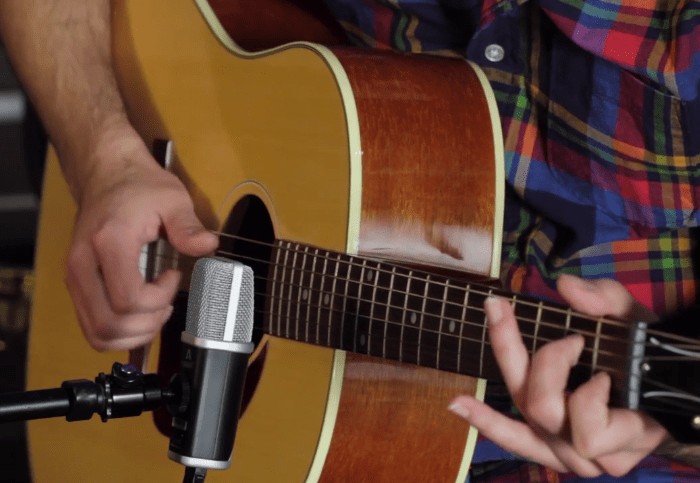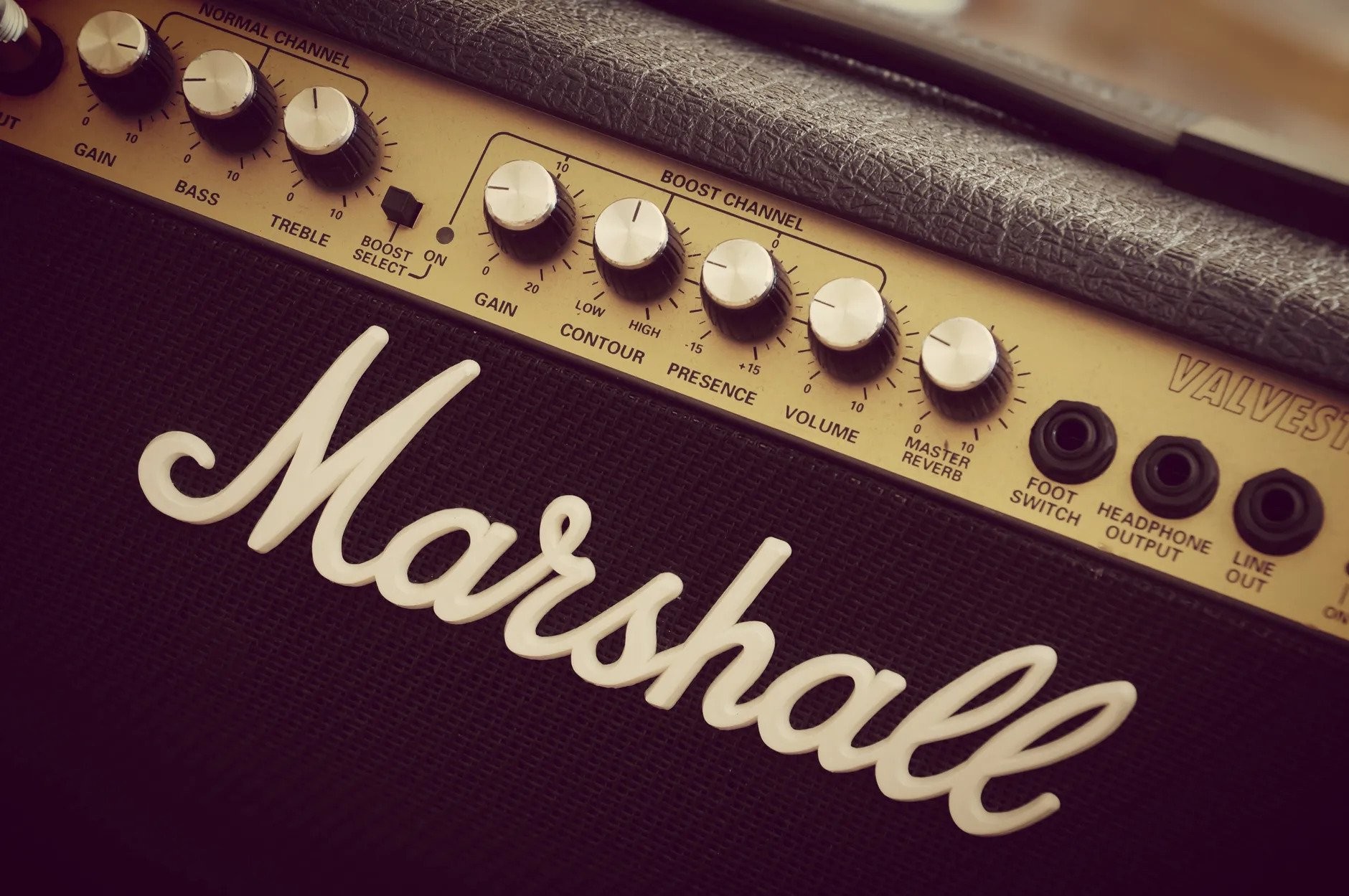Is It Easier To Learn Acoustic Or Electric Guitar? Uncover the truth with LEARNS.EDU.VN, where we simplify the guitar learning journey. We offer a clear perspective on choosing the right instrument, considering factors like playability, sound, and inspiration. Discover the optimal starting point for your musical journey, exploring instrumental music and chord progressions.
1. Debunking Common Myths About Learning Guitar
Many aspiring guitarists find themselves caught in a web of misconceptions about the “right” way to start learning. Let’s dispel some of these myths to clear the path for your musical journey.
1.1. Myth: You Must Learn On Acoustic Guitar First
One of the most pervasive myths is that beginners should always start with an acoustic guitar before moving on to an electric. The reasoning behind this is that acoustic guitars require more finger strength and can be more challenging to play. It’s believed that mastering the acoustic guitar first makes the electric guitar seem easier in comparison.
While there’s some logic to this idea, it’s not a universal truth. Many successful guitarists, including myself, started with an electric guitar and transitioned to acoustic later. The key is to adjust your technique slightly. On an acoustic, you may need to press down harder on the strings, and the neck may feel wider. However, the fundamental techniques, chord shapes, and musical concepts remain the same.
If your primary inspiration comes from acoustic guitarists and singer-songwriters, then starting with an acoustic guitar makes perfect sense. However, if you dream of shredding like your electric guitar heroes, diving straight into the electric guitar might be the more motivating choice. Ultimately, the best guitar to start with is the one that inspires you to pick it up and play.
1.2. Myth: You Need an Amplifier to Play Electric Guitar
Another common misconception is that you can’t hear an electric guitar without an amplifier. While it’s true that an amplifier is essential for performing and achieving a wide range of tones, you can still practice and learn on an electric guitar without one.
Unplugged, an electric guitar produces a quieter sound than an acoustic, but it’s certainly audible enough for practicing at home. In fact, many guitarists, even experienced ones, often pick up their electric guitars and practice unplugged for convenience.
While purchasing an amplifier alongside your electric guitar is ideal, it’s not a necessity for beginners. You can always invest in an amp later once you’ve developed your skills and are ready to explore the full potential of the instrument. Don’t let the perceived need for an amplifier deter you from starting with an electric guitar if that’s what truly excites you.
1.3. Myth: You Should Learn on Classical Guitar First
Some people suggest starting with a classical guitar because the nylon strings are softer and easier on the fingers. While it’s true that nylon strings are gentler, classical guitars have a wider neck than acoustic or electric guitars. This can pose challenges for beginners, requiring a specific left-hand technique.
Classical guitars are ideal for those interested in classical or flamenco music. If your goal is to play your favorite pop, rock, or country songs, an acoustic or electric guitar would be a better choice. The techniques and skills learned on these guitars will be more relevant to your musical aspirations.
2. Acoustic vs. Electric Guitar: Which is Easier to Learn?
The question of whether it’s easier to learn on an acoustic or electric guitar is subjective and depends on individual preferences and goals. There’s no one-size-fits-all answer. The best choice depends on what inspires you and keeps you motivated to play.
If you dream of playing like iconic electric guitarists such as Jimi Hendrix, Eric Clapton, or Slash, then starting with an electric guitar will likely be more inspiring. The ability to experiment with different tones, effects, and techniques can be highly motivating.
On the other hand, if you’re drawn to the singer-songwriter style of artists like Ed Sheeran, Taylor Swift, or John Mayer, an acoustic guitar might be a better fit. The simplicity and portability of the acoustic guitar can be appealing, and it’s well-suited for playing chords and strumming along to your favorite songs.
3. In-Depth Comparison: Acoustic vs. Electric Guitar
To provide a more comprehensive understanding, let’s delve into a detailed comparison of acoustic and electric guitars, considering various factors relevant to beginners.
3.1. Playability and Comfort
- String Tension: Electric guitars typically have lighter gauge strings and lower string tension, making them easier to press down and fret. This can be particularly beneficial for beginners who haven’t yet developed the finger strength required for acoustic guitars.
- Neck Size and Shape: Electric guitar necks tend to be narrower and have a slimmer profile than acoustic guitar necks. This can make it easier for beginners to reach chords and navigate the fretboard.
- Action: The “action” refers to the height of the strings above the fretboard. Electric guitars often have a lower action than acoustic guitars, which means the strings are closer to the frets and require less pressure to play.
3.2. Sound and Tone
- Acoustic Guitar: Acoustic guitars produce sound naturally through the vibration of the strings and the resonance of the guitar’s body. They offer a warm, natural tone that’s well-suited for a wide range of musical styles.
- Electric Guitar: Electric guitars require an amplifier to produce sound. The guitar’s pickups convert the strings’ vibrations into an electrical signal, which is then amplified. Electric guitars offer a vast range of tonal possibilities, from clean and mellow to distorted and aggressive.
3.3. Learning Curve and Technique
- Acoustic Guitar: Acoustic guitars can be more challenging for beginners due to the higher string tension and wider necks. Developing the necessary finger strength and dexterity can take time and effort. However, mastering the acoustic guitar can provide a strong foundation for playing other types of guitars.
- Electric Guitar: Electric guitars are generally considered easier to play for beginners due to the lighter strings, narrower necks, and lower action. This can make it easier to learn chords, scales, and basic techniques. However, electric guitar also introduces the complexities of amplifiers, effects, and tone shaping.
3.4. Cost and Equipment
- Acoustic Guitar: Acoustic guitars are generally less expensive than electric guitars and require less additional equipment. A basic acoustic guitar package might include a guitar, a gig bag, a tuner, and a few picks.
- Electric Guitar: Electric guitar setups can be more expensive due to the need for an amplifier, a cable, and potentially effects pedals. However, beginner-friendly electric guitar packages are available that include all the necessary equipment at an affordable price.
3.5. Musical Styles and Preferences
- Acoustic Guitar: Acoustic guitars are well-suited for folk, country, blues, pop, and singer-songwriter styles.
- Electric Guitar: Electric guitars are commonly used in rock, metal, blues, jazz, and pop music.
4. Pros and Cons of Learning on Electric Guitar
To help you weigh the options, here’s a summary of the pros and cons of starting with an electric guitar:
Pros:
- Lighter strings make it easier to press down and play.
- Easier to learn lead guitar techniques like string bending and tapping.
- More commonly used in bands.
- Offers more options for shaping your sound with effects.
- Encourages musical expression.
Cons:
- Requires an amplifier for public performance.
- May need to adjust technique slightly for acoustic guitar.
- Electric guitars can be heavier than acoustic guitars.
5. Pros and Cons of Learning on Acoustic Guitar
Here’s a breakdown of the advantages and disadvantages of learning on an acoustic guitar:
Pros:
- The transition to electric guitar may be easier.
- No need for an amplifier initially.
- Great for playing songs in social gatherings.
- More suited to certain techniques like fingerstyle.
- Promotes better finger strength.
Cons:
- Harder to press down on the strings initially.
- Not ideal for some lead guitar techniques.
- You may need an electric guitar to join a band.
6. Expert Advice on Buying Your First Guitar
Regardless of whether you choose an acoustic or electric guitar, it’s essential to invest in the best instrument you can afford. A higher-quality guitar will typically play better, sound better, and be more enjoyable to learn on.
As a general rule, the higher the price range, the better the quality of the instrument. Consider your budget and try to find a guitar that offers the best value for your money. A guitar you’re proud to own will inspire you to practice more often, accelerating your progress.
In addition to purchasing a good guitar, consider taking lessons from a qualified instructor. A good teacher can provide guidance, feedback, and motivation, helping you avoid bad habits and develop proper technique. Look for a teacher who is experienced in the style of music you want to learn.
7. Essential Accessories for Beginners
Whether you choose an acoustic or electric guitar, a few essential accessories will enhance your learning experience:
- Tuner: A tuner is essential for keeping your guitar in tune. Electronic tuners are accurate and easy to use, making them ideal for beginners.
- Picks: Guitar picks come in various thicknesses and materials. Experiment with different picks to find the ones that feel most comfortable and produce the sound you prefer.
- Gig Bag: A gig bag protects your guitar from scratches and bumps during transport.
- Guitar Strap: A guitar strap allows you to play your guitar while standing up.
- Guitar Stand: A guitar stand keeps your guitar safe and accessible when you’re not playing it.
8. Setting Realistic Goals and Expectations
Learning to play the guitar takes time, patience, and dedication. It’s important to set realistic goals and expectations to avoid frustration and maintain motivation.
- Start Small: Begin by learning a few basic chords and simple songs. As you progress, you can gradually increase the difficulty of the material you’re learning.
- Practice Regularly: Aim to practice for at least 30 minutes each day. Consistent practice is more effective than sporadic, longer sessions.
- Be Patient: Don’t get discouraged if you don’t see results immediately. It takes time to develop the necessary skills and coordination.
- Have Fun: Remember that learning to play the guitar should be enjoyable. Choose songs you love and focus on having fun while you practice.
9. Staying Motivated on Your Guitar Journey
Maintaining motivation is crucial for long-term success in learning guitar. Here are some tips to help you stay inspired:
- Set Achievable Goals: Break down your learning into smaller, manageable goals.
- Find a Practice Buddy: Learning with a friend can make the process more fun and engaging.
- Join a Guitar Community: Connect with other guitarists online or in person to share tips, ask questions, and get support.
- Record Your Progress: Tracking your progress can be motivating and help you identify areas where you need to improve.
- Reward Yourself: Celebrate your accomplishments by treating yourself to new gear, attending a concert, or simply taking a break.
- Explore Different Genres: Don’t limit yourself to one style of music. Experiment with different genres to broaden your musical horizons.
- Learn Your Favorite Songs: Playing songs you love can be a great way to stay motivated and engaged.
- Perform for Others: Sharing your music with friends and family can be a rewarding experience and boost your confidence.
10. The Role of Online Resources and Guitar Lessons
In today’s digital age, a wealth of online resources can supplement your guitar learning journey. YouTube channels, websites, and apps offer tutorials, lessons, and tips for guitarists of all levels.
However, online resources should not replace traditional guitar lessons entirely. A qualified instructor can provide personalized guidance, correct your technique, and help you avoid bad habits. The combination of online resources and in-person lessons can be a powerful approach to learning guitar.
LEARNS.EDU.VN offers a variety of resources to support your guitar learning journey, including articles, tutorials, and a directory of qualified guitar instructors. Visit our website to discover more!
11. Common Challenges Faced by Beginner Guitarists
Even with the best intentions and resources, beginner guitarists often encounter common challenges:
- Finger Pain: Developing calluses on your fingertips takes time, and finger pain is a common complaint among beginners.
- Chord Changes: Smoothly transitioning between chords can be difficult at first.
- Rhythm and Timing: Maintaining a steady rhythm and playing in time can be challenging.
- Finger Dexterity: Developing the necessary finger dexterity and coordination takes practice.
- Frustration: It’s normal to feel frustrated at times, especially when you’re struggling with a particular technique.
12. Effective Practice Techniques for Faster Progress
To overcome these challenges and accelerate your progress, incorporate these effective practice techniques into your routine:
- Slow Practice: Practice slowly and deliberately, focusing on accuracy and technique.
- Repetition: Repeat difficult passages multiple times until you can play them smoothly.
- Chunking: Break down complex pieces into smaller, more manageable chunks.
- Metronome Practice: Use a metronome to improve your rhythm and timing.
- Active Listening: Listen carefully to the music you’re learning and pay attention to the details.
- Targeted Practice: Identify your weaknesses and focus your practice on those areas.
- Deliberate Practice: Practice with a specific goal in mind and focus on improving a particular skill.
- Mindful Practice: Pay attention to your body and mind while you practice, and avoid distractions.
13. Exploring Different Guitar Styles and Genres
As you progress on your guitar journey, explore different styles and genres of music. This will broaden your musical horizons, improve your skills, and keep you motivated.
- Blues: Learn the blues scale and basic blues techniques.
- Rock: Explore different rock subgenres, such as classic rock, hard rock, and alternative rock.
- Country: Learn country chords, fingerpicking patterns, and chicken pickin’ techniques.
- Jazz: Study jazz chords, scales, and improvisation techniques.
- Classical: Explore classical guitar repertoire and techniques.
- Folk: Learn folk songs, fingerstyle techniques, and open tunings.
14. The Importance of Ear Training for Guitarists
Ear training is a crucial skill for any musician, and it’s especially important for guitarists. Ear training helps you develop the ability to recognize intervals, chords, and melodies by ear. This can improve your improvisation skills, songwriting abilities, and overall musicianship.
- Interval Recognition: Learn to identify different intervals, such as major thirds, perfect fifths, and minor sevenths.
- Chord Recognition: Practice identifying different chord types, such as major, minor, dominant, and diminished.
- Melodic Dictation: Try to transcribe simple melodies by ear.
- Singing: Singing along with your guitar playing can improve your ear and your vocal skills.
- Online Ear Training Resources: Many websites and apps offer ear training exercises and resources.
15. Guitar Maintenance and Care
Proper guitar maintenance is essential for keeping your instrument in good playing condition.
- String Changes: Replace your strings regularly, typically every 1-3 months, depending on how often you play.
- Cleaning: Clean your guitar regularly with a soft cloth to remove dirt and grime.
- Humidification: Keep your acoustic guitar properly humidified, especially in dry climates.
- Setup: Have your guitar professionally set up by a qualified technician.
- Storage: Store your guitar in a case or on a stand in a safe place.
16. Advanced Guitar Techniques to Explore
Once you’ve mastered the basics, you can explore more advanced guitar techniques:
- String Bending: Bending strings to create expressive vibrato and melodic embellishments.
- Tapping: Using your fingers to tap notes on the fretboard.
- Sweep Picking: A technique for playing fast arpeggios.
- Alternate Picking: A picking technique that involves alternating between upstrokes and downstrokes.
- Hybrid Picking: A technique that combines flatpicking and fingerpicking.
- Harmonics: Creating bell-like tones by lightly touching the strings.
17. The Benefits of Playing Guitar for Mental and Physical Health
Playing guitar offers numerous benefits for both mental and physical health:
- Stress Relief: Playing guitar can be a relaxing and therapeutic activity.
- Cognitive Benefits: Learning to play guitar can improve your memory, focus, and problem-solving skills.
- Coordination: Playing guitar can improve your hand-eye coordination and fine motor skills.
- Creativity: Playing guitar can be a creative outlet and allow you to express yourself.
- Social Connection: Playing guitar in a band or with other musicians can foster social connection and a sense of community.
- Self-Esteem: Mastering new skills on the guitar can boost your self-esteem and confidence.
- Physical Exercise: Playing guitar can provide a mild form of physical exercise, improving your posture and circulation.
18. The Future of Guitar Learning: Technology and Innovation
Technology continues to transform the way we learn guitar:
| Innovation | Description | Benefits |
|---|---|---|
| Interactive Apps | Apps that provide real-time feedback on your playing, track your progress, and offer personalized lessons. | Enhanced learning experience, improved accuracy, and increased motivation. |
| Virtual Reality (VR) | VR simulations that allow you to practice guitar in immersive and realistic environments. | Realistic practice experience, improved muscle memory, and reduced anxiety. |
| AI-Powered Tutors | AI-powered tutors that can analyze your playing, identify areas for improvement, and provide personalized feedback. | Personalized learning experience, faster progress, and more efficient practice. |
| Online Communities | Online platforms and forums where guitarists can connect, share tips, and collaborate on music projects. | Social connection, support, and access to a wealth of knowledge and experience. |
| Smart Guitars | Guitars equipped with sensors and technology that can track your playing and provide real-time feedback. | Improved accuracy, enhanced learning experience, and personalized practice routines. |
| Gamification | Incorporation of game-like elements into guitar learning apps and platforms. | Increased engagement, motivation, and fun. |




19. Case Studies: Success Stories of Beginner Guitarists
Inspirational stories of individuals who overcame challenges and achieved their guitar playing goals:
- Sarah: A busy professional who always dreamed of playing guitar. By dedicating just 30 minutes a day to practice, she was able to learn her favorite songs within a year.
- David: A retired teacher who picked up the guitar in his 60s. Despite initial challenges with finger pain, he persevered and now plays in a local band.
- Maria: A young student who used online resources and a local guitar teacher to learn how to play lead guitar. She now performs regularly at school events.
- John: Overcame initial frustration by setting small achievable goals. He started with basic chords and simple songs, gradually increasing the difficulty.
- Emily: Found a practice buddy to make learning more fun and engaging. They supported each other, shared tips, and celebrated their progress together.
20. Frequently Asked Questions (FAQs) About Learning Guitar
Here are some frequently asked questions about learning guitar:
- Q: How long does it take to learn to play the guitar?
- A: It depends on your goals, practice habits, and learning style. You can learn basic chords and songs within a few months, but mastering the guitar takes years of dedication.
- Q: Is it too late to learn guitar as an adult?
- A: Absolutely not! Many adults successfully learn to play the guitar.
- Q: What’s the best way to learn guitar?
- A: A combination of in-person lessons, online resources, and consistent practice is ideal.
- Q: How much should I practice each day?
- A: Aim for at least 30 minutes of practice each day.
- Q: What are the easiest songs to learn on guitar?
- A: “Knockin’ on Heaven’s Door,” “House of the Rising Sun,” and “Hallelujah” are popular choices for beginners.
- Q: What’s the best type of guitar for beginners?
- A: Both acoustic and electric guitars can be suitable for beginners. The best choice depends on your preferences and musical goals.
- Q: Do I need to learn music theory to play guitar?
- A: While not essential, learning basic music theory can enhance your understanding of music and improve your playing.
- Q: How can I improve my finger strength for guitar?
- A: Regular practice will gradually build your finger strength.
- Q: What are some common mistakes to avoid when learning guitar?
- A: Poor posture, incorrect hand positioning, and neglecting ear training are common mistakes.
- Q: How can I stay motivated when learning guitar?
- A: Set realistic goals, find a practice buddy, and learn songs you love.
Embark on your guitar journey with confidence. Whether you choose acoustic or electric, remember that the most important thing is to enjoy the process and never stop learning.
Ready to start your guitar journey? Visit learns.edu.vn today for more helpful resources, articles, and a directory of qualified guitar instructors. Let us help you unlock your musical potential! Our comprehensive resources and expert guidance will empower you to achieve your musical aspirations. Don’t wait – start your musical adventure today! Contact us at 123 Education Way, Learnville, CA 90210, United States or Whatsapp: +1 555-555-1212.